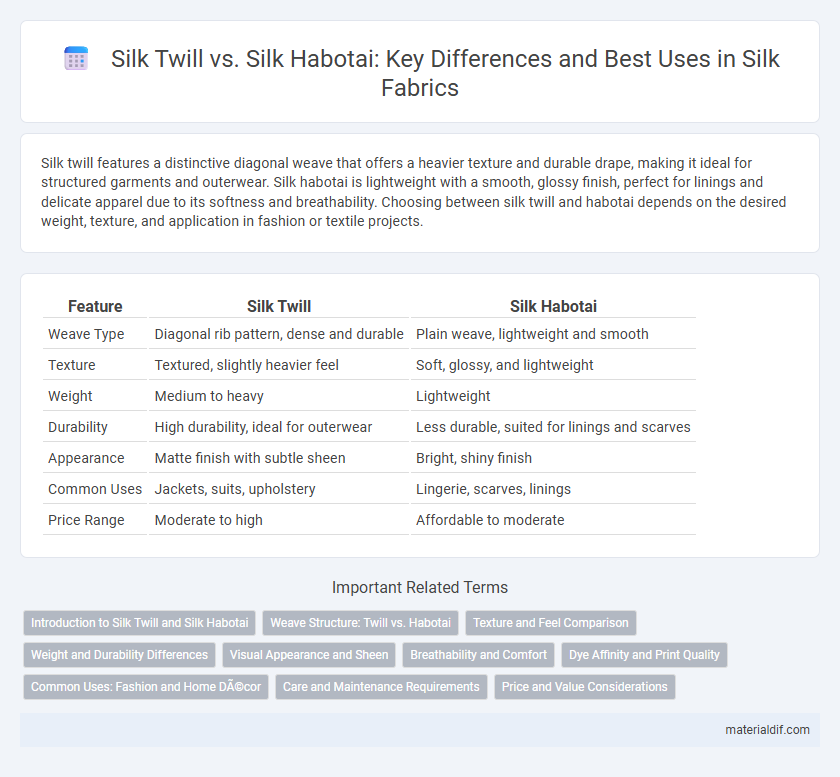Silk twill features a distinctive diagonal weave that offers a heavier texture and durable drape, making it ideal for structured garments and outerwear. Silk habotai is lightweight with a smooth, glossy finish, perfect for linings and delicate apparel due to its softness and breathability. Choosing between silk twill and habotai depends on the desired weight, texture, and application in fashion or textile projects.
Table of Comparison
| Feature | Silk Twill | Silk Habotai |
|---|---|---|
| Weave Type | Diagonal rib pattern, dense and durable | Plain weave, lightweight and smooth |
| Texture | Textured, slightly heavier feel | Soft, glossy, and lightweight |
| Weight | Medium to heavy | Lightweight |
| Durability | High durability, ideal for outerwear | Less durable, suited for linings and scarves |
| Appearance | Matte finish with subtle sheen | Bright, shiny finish |
| Common Uses | Jackets, suits, upholstery | Lingerie, scarves, linings |
| Price Range | Moderate to high | Affordable to moderate |
Introduction to Silk Twill and Silk Habotai
Silk twill features a distinctive diagonal weave that provides a smooth texture and durable finish, making it ideal for structured garments and high-end fashion. Silk habotai, also known as China silk, boasts a lightweight, plain weave that offers soft drape and breathability, commonly used for linings and delicate apparel. Both fabrics originate from natural silk fibers but differ significantly in weave structure, weight, and application, influencing their appearance and functionality in textile design.
Weave Structure: Twill vs. Habotai
Silk twill features a diagonal weave pattern that creates a textured surface with enhanced durability and a slight sheen, making it ideal for garments requiring structure and drape. Silk habotai, known for its plain weave, produces a smooth, lightweight fabric with a soft hand and subtle shine, commonly used in linings and delicate apparel. The twill weave's overlapping yarns provide greater resilience and opacity compared to the more delicate and breathable habotai weave.
Texture and Feel Comparison
Silk twill features a diagonal weave that creates a pronounced texture with a slightly heavier weight, offering a smooth yet structured feel ideal for tailored garments and upholstery. Silk habotai is woven in a plain weave, resulting in a lightweight, soft, and smooth fabric with a subtle sheen that drapes delicately, making it perfect for linings and flowing apparel. The distinct weave patterns directly influence their tactile qualities, with twill providing durability and body, while habotai emphasizes lightness and softness.
Weight and Durability Differences
Silk twill is heavier and more durable than silk habotai, with a typical weight ranging from 45 to 60 grams per square meter compared to habotai's lighter 16 to 30 grams per square meter. The twill weave creates a tighter, diagonal pattern that enhances fabric strength and resistance to wear, making it ideal for garments requiring longevity. In contrast, silk habotai's plain weave results in a softer, more delicate fabric suited for lightweight scarves and linings but less resistant to abrasion.
Visual Appearance and Sheen
Silk twill features a distinctive diagonal weave pattern that creates a textured surface with rich depth, producing a lustrous sheen that catches light dynamically. In contrast, silk habotai has a smooth, flat weave resulting in a soft, matte finish with a subtle, understated shine. The vibrant, polished glimmer of silk twill enhances visual richness, while silk habotai offers a gentle, elegant luminosity ideal for lightweight garments.
Breathability and Comfort
Silk twill features a tighter weave that offers moderate breathability while providing a smooth, sturdy texture ideal for structured garments. Silk habotai is lightweight with an open weave, enhancing airflow and maximizing comfort for warm weather or layering. The breathable nature of habotai makes it preferable for softness and moisture-wicking properties compared to the denser, less ventilated twill.
Dye Affinity and Print Quality
Silk twill features a diagonal weave that enhances dye absorption, resulting in richer, more vibrant colors and sharper print details compared to silk habotai. Silk habotai, characterized by its smooth, plain weave, absorbs dyes more lightly, often producing softer, muted prints with less color saturation. For applications requiring intense color vibrancy and precise print quality, silk twill is the preferable fabric choice over silk habotai.
Common Uses: Fashion and Home Décor
Silk twill's diagonal weave creates a rich texture ideal for tailored garments like blazers and dresses, as well as home decor items such as cushion covers and curtains, where durability and subtle sheen are desired. Silk habotai, known for its lightweight and smooth finish, is commonly used in flowing dresses, scarves, and delicate linings, as well as soft draperies and luxurious pillowcases in interior design. Both fabrics offer unique tactile qualities that enhance fashion collections and elegant home environments.
Care and Maintenance Requirements
Silk twill requires gentle hand washing with mild detergent and should be dried flat to maintain its diagonal weave and sheen, while avoiding direct sunlight to prevent fabric weakening. Silk habotai, being lighter and more delicate, demands even more careful handling such as cold water hand washing and air drying away from heat to preserve its smooth, soft texture. Both fabrics benefit from low-heat ironing on the reverse side and storage in breathable conditions to prevent damage and maintain longevity.
Price and Value Considerations
Silk twill typically commands a higher price than silk habotai due to its denser weave and enhanced durability, making it ideal for luxury garments and upholstery. Despite its lower cost, silk habotai offers excellent value for lightweight apparel and linings, with a smooth texture and good drape that justify its affordability. Choosing between silk twill and silk habotai depends on balancing budget constraints against the desired fabric strength and aesthetic qualities for the intended project.
Silk twill vs Silk habotai Infographic

 materialdif.com
materialdif.com